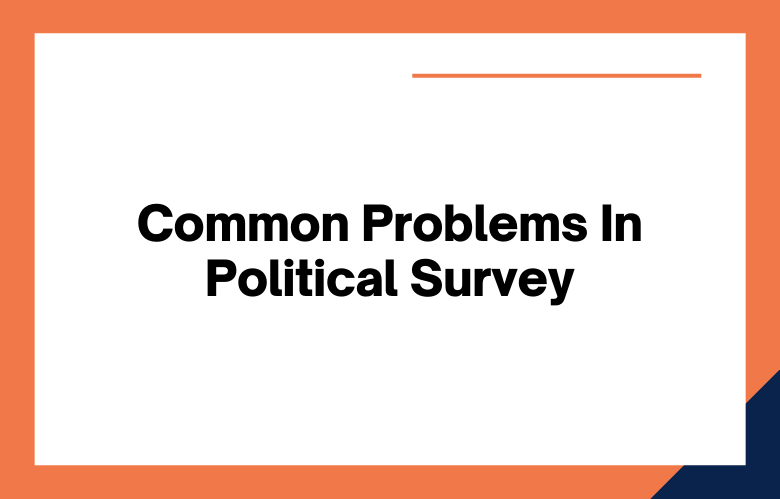The success of any political campaign is determined by how many people are inclined to vote for the candidate. The number of votes speaks volumes about the public support that a politician can garner.
To reach out to many voters, politicians design surveys that help them know what issues matter to voters and which don’t.
However, designing an effective survey can be challenging because there are several factors at play here, including understanding different personality types so you can better gauge their response.
Political surveys are essential for any political party to gather information about their voters and understand the public’s opinion on various issues.
These surveys help in identifying problems that might affect the party during elections.
However, designing a successful survey is not as simple as it sounds; plenty of common mistakes are made while preparing these polls.
Here are the tips for avoiding these common problems while designing an effective political survey.
What is a Political Survey?
A political survey is a quick poll that candidates use to get feedback from the public.
A political survey is a set of questions to gather information to create an election strategy.
A political survey is a way to gain insights into public opinion. This is a great way to find out if you want to know how people feel about specific issues.
A political survey is a question to help you understand how people think about politics.
A political survey is an essential tool that helps people plan for the future.
A political survey is a questionnaire people fill out to hear their opinions.
Common Problems while Designing an Effective Political Survey
- Not including a question about the respondent’s party affiliation
- Including too many questions that are not relevant to the topic
- A lack of demographic information, such as age and gender
- The survey is too long or poorly worded
- Not enough respondents
- Respondents are biased or unqualified to answer the questions
- Questions are too complicated for people to understand easily
- The survey is not designed well
- The survey is too long
- The questions are not transparent or not worded well
- People don’t want to answer the survey because it’s hard to understand, they’re embarrassed, or they don’t want their answers shared with other people
- The questions are biased and only ask about one side of an issue
What Are The Common Questions In Designing Effective Political Surveys?
- How to get good responses
- How to find people who are willing to respond
- What questions should be asked in the survey
- Who will take responsibility for conducting the study?
- Consider how the survey will be distributed
- Is it an open-ended or closed question?
- How many questions should I ask?
- What is my desired response rate?
- Where do I get a list of possible items to include in the survey?
- How to get people to take the survey
- What questions should be asked in the survey
- Should the survey be anonymous or not?
- When do you stop asking questions in a survey?
- How do I ensure that my survey is unbiased?
- What should I ask in a political survey?
- Who should take the survey?
- Where will I find respondents to take my survey?
- What are the main objectives of this survey?
- Who is your target population?
- How will you measure the effectiveness of the survey?
- What are the possible sources of bias in data collection?
- How much time do you have to complete this project before it’s due?
Ways to Design an Effective Political Survey
- Ask questions that are easy to answer
- Keep the survey short, ideally less than 10 minutes
- Make sure it’s anonymous and confidential
- Offer incentives for completing the study (i.e., a chance to win a prize)
- Survey a representative sample of the population
- Make sure there is an unambiguous question in your survey
- Ask respondents to answer questions on a scale from 1-5, with 5 being the most favorable response
- Include an open-ended question that asks for their thoughts or opinions about something you want to know more about
- Keep survey questions simple and clear
- Raise only one question at a time
- Avoid using words that are too difficult to understand or have multiple meanings.
- Include an answer scale with the question so respondents know what they’re being asked to do when answering each question.
- Ensure there is enough space for people to write their answers on the form
- Write a clear, concise purpose statement
- Include demographic questions to ensure that your survey is representative of the population you are surveying
- Make sure the question wording is unbiased and neutral; avoid leading or loaded questions
- Avoid asking yes/no type questions where there are more than two possible responses (e.g., “Do you like ice cream?”)
- Use open-ended response boxes for any text entry instead of radio buttons or checkboxes
- Create a demographic survey that asks for age, gender, and ethnicity
- Ask about the respondent’s political views on various issues such as abortion, gun control, and healthcare
- Have respondents rank their level of agreement with certain statements
- allow participants to provide feedback or suggestions
- Create a survey with questions that are clear, concise, and unbiased
- Ask questions about candidate policies to gauge their effectiveness
- Make the survey short so people will take it seriously
- Include demographic information to see if there are any trends in responses
- Make the survey quick, with no more than ten questions
- Ask open-ended questions to encourage respondents to give thoughtful answers
- Use neutral language that avoids biases or assumptions
- Include a variety of different types of questions, such as multiple choice and yes/no options
- Include a clear purpose statement that explains the survey’s goal
- Create an unbiased question wording that is not leading or biased
- Ask only one question per page, and break up questions into categories
- Use neutral language when possible, such as “Do you support raising taxes on gas?” rather than “Should we raise taxes on gas?”
- Avoid using words like always or never in questions- these are absolutes and will skew responses to be more extreme than they may need to be
- Develop a straightforward research question
- Gather enough data to answer the question
- Design an effective survey with questions that are unbiased and objective
- Ask respondents to share their opinions anonymously, if possible
- Make sure your survey is short so people will take it seriously
- Survey as fast as possible
- Ask for demographic information, such as age and race
- Include a space to provide feedback on the survey itself so that you can improve it in future surveys
- Avoid using jargon or acronyms that some people might not understand
- Make sure questions are unambiguous.
Conclusion
The collected information needs to be gathered in a way that will provide accurate and valuable data. Asking the right and relevant questions at the start of the survey design can make all the difference in getting a reasonable response rate and identifying gaps in knowledge or perception on behalf of those surveyed. Contact us for political consulting services today!
One way to get in touch is by filling out our online form on this site or give us a call at +91 9848321284. Let’s work together today!











